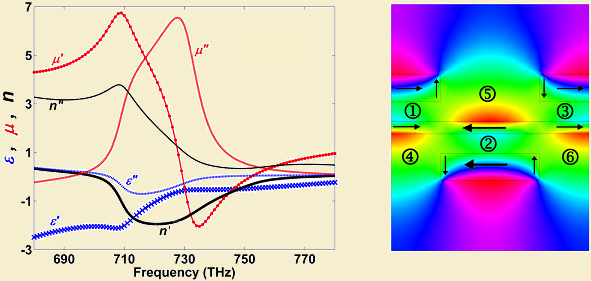
Stretching Negative Index Metamaterials to Ultraviolet? [Nov 15, 2011]
Metamaterials are artificial materials that exhibit properties not seen in nature. If designed properly, metamaterials could make the magical real. You could make a 'perfect lens' with arbitrarily high resolution, use your cell phone as a microscope, levitate objects with a laser beam, make yourself vanish, simulate exotic phenomena with light [1,2], create dynamic optical illusions, and more. However, despite remarkable progress, metamaterials are still 'under construction.' The perfect lens [3] is an example. The most fascinating application driving the field, it would ideally require a negative refractive index [4] at as high frequency as possible with the smallest possible feature size.
We have demonstrated how the operating frequency of negative index metamaterials can cover the entire visible spectrum and possibly be stretched to ultraviolet wavelengths using silver thin films (see Figure below) [5]. Previously there was no demonstration of negative index below yellow wavelengths [6], either theoretically or experimentally. The work not only brings extremely high-resolution, low-cost imaging and lithography closer to reality, it may also enable the development of optical components at ultraviolet regions for applications ranging from solar cells, lasers, and detectors to broadband and high-density integrated optics.

(Left) Retrieved effective parameters of the thin film plasmonic metamaterial structure. The structure has simultaneously negative effective electric permittivity and effective magnetic permeability. The corresponding refractive index is negative over 70 THz bandwidth (702 to 772 THz, very close to UV) with a large figure of merit of 2.27. (Right) The colors show magnetic fields generated by surface plasmons. The black arrows show the direction of electrical current in metallic layers, and the numbers indicate current loops that contribute to negative refraction.
Our work received wide media coverage. See for example,
- Almost Perfect: Michigan Tech Researcher Nears Creation of Superlens, Marcia Goodrich, Michigan Tech News (Jan 16, 2012).
- Metamaterial Superlenses for the Visible and UV, Yvonne Carts-Powell, Optics & Photonics News (2012, Jan)
- Ultra-high-resolution Microscopes Could Become as Common as Phone Cameras, Olivia Solon, Wired.Co.UK (Jan 10, 2012).
- Almost Perfect: Researcher Nears Creation of Superlens, ScienceDaily (Jan 9, 2012).
- Superlens Nears Development, in Theory, Photonics.Com (Jan 11, 2012).
- Scientist Closes in on Creating a Superlens, Ben Coxworth, Gizmag (Jan 13, 2012).
- Superlens Nears Development, in Theory, Ashley N. Paddock, Biophotonics (2012, Mar).
References
[1] D. O. Guney and D. A. Meyer, Negative refraction gives rise to the Klein paradox, Phys. Rev. A 79, 063834 (2009).
[2] D. A. Genov, S. Zhang, and X. Zhang, Mimicking celestial mechanics in metamaterials, Nature Phys. 5, 687 (2009).
[3] J. B. Pendry, Negative refraction makes a perfect lens, Phys. Rev. Lett. 85, 3966 (2000).
[4] R. A. Shelby, D. R. Smith, S. Schultz, Experimental verification of a negative index of refraction, Science 292, 77 (2001).
[5] M. I. Aslam and D. O. Guney, Surface plasmon driven scalable low-Loss negative-index metamaterial in the visible spectrum, Phys. Rev. B 84, 195465 (2011).
[6] S. Xiao, U. K. Chettiar, A. V. Kildishev, V. P. Drachev, and V. M. Shalaev, Yellow-light negative-index metamaterials, Opt. Lett., 34, 3478 (2009).